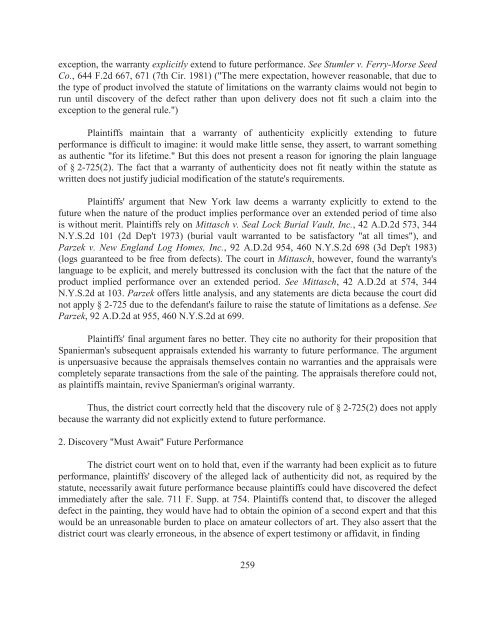Sales and Leases - A Problem-based Approach, 2016a
Sales and Leases - A Problem-based Approach, 2016a
Sales and Leases - A Problem-based Approach, 2016a
Create successful ePaper yourself
Turn your PDF publications into a flip-book with our unique Google optimized e-Paper software.
exception, the warranty explicitly extend to future performance. See Stumler v. Ferry-Morse Seed<br />
Co., 644 F.2d 667, 671 (7th Cir. 1981) ("The mere expectation, however reasonable, that due to<br />
the type of product involved the statute of limitations on the warranty claims would not begin to<br />
run until discovery of the defect rather than upon delivery does not fit such a claim into the<br />
exception to the general rule.")<br />
Plaintiffs maintain that a warranty of authenticity explicitly extending to future<br />
performance is difficult to imagine: it would make little sense, they assert, to warrant something<br />
as authentic "for its lifetime." But this does not present a reason for ignoring the plain language<br />
of § 2-725(2). The fact that a warranty of authenticity does not fit neatly within the statute as<br />
written does not justify judicial modification of the statute's requirements.<br />
Plaintiffs' argument that New York law deems a warranty explicitly to extend to the<br />
future when the nature of the product implies performance over an extended period of time also<br />
is without merit. Plaintiffs rely on Mittasch v. Seal Lock Burial Vault, Inc., 42 A.D.2d 573, 344<br />
N.Y.S.2d 101 (2d Dep't 1973) (burial vault warranted to be satisfactory "at all times"), <strong>and</strong><br />
Parzek v. New Engl<strong>and</strong> Log Homes, Inc., 92 A.D.2d 954, 460 N.Y.S.2d 698 (3d Dep't 1983)<br />
(logs guaranteed to be free from defects). The court in Mittasch, however, found the warranty's<br />
language to be explicit, <strong>and</strong> merely buttressed its conclusion with the fact that the nature of the<br />
product implied performance over an extended period. See Mittasch, 42 A.D.2d at 574, 344<br />
N.Y.S.2d at 103. Parzek offers little analysis, <strong>and</strong> any statements are dicta because the court did<br />
not apply § 2-725 due to the defendant's failure to raise the statute of limitations as a defense. See<br />
Parzek, 92 A.D.2d at 955, 460 N.Y.S.2d at 699.<br />
Plaintiffs' final argument fares no better. They cite no authority for their proposition that<br />
Spanierman's subsequent appraisals extended his warranty to future performance. The argument<br />
is unpersuasive because the appraisals themselves contain no warranties <strong>and</strong> the appraisals were<br />
completely separate transactions from the sale of the painting. The appraisals therefore could not,<br />
as plaintiffs maintain, revive Spanierman's original warranty.<br />
Thus, the district court correctly held that the discovery rule of § 2-725(2) does not apply<br />
because the warranty did not explicitly extend to future performance.<br />
2. Discovery "Must Await" Future Performance<br />
The district court went on to hold that, even if the warranty had been explicit as to future<br />
performance, plaintiffs' discovery of the alleged lack of authenticity did not, as required by the<br />
statute, necessarily await future performance because plaintiffs could have discovered the defect<br />
immediately after the sale. 711 F. Supp. at 754. Plaintiffs contend that, to discover the alleged<br />
defect in the painting, they would have had to obtain the opinion of a second expert <strong>and</strong> that this<br />
would be an unreasonable burden to place on amateur collectors of art. They also assert that the<br />
district court was clearly erroneous, in the absence of expert testimony or affidavit, in finding<br />
259


















